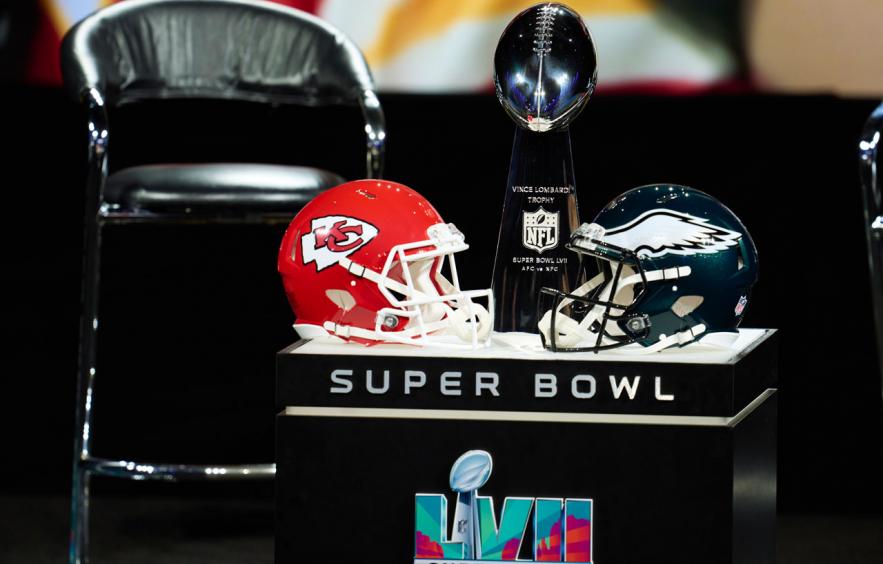Predicting Super Bowl 57's Exact Score & How to Bet On It

"Vegas knows!" is a common phrase muttered by sports bettors and analysts everywhere. A lot of people trust the numbers sportsbooks produce, whether it's for building projections or for informing other decisions. But do sportsbooks know how to predict the exact score of a game accurately?
In this article, I will evaluate how good sportsbook spreads and totals are at predicting a game's exact score. Additionally, I'll use a couple of analytical approaches to predict the exact score of Super Bowl 57.
The data used in this article is from nflfastR and all betting data are closing lines from Pinnacle Sportsbook.
Super Bowl LVII Matchup
- Matchup: Kansas City Chiefs vs. Philadelphia Eagles
- Date: Sunday, February 12th, 2023
- Time: 6:30 PM EST
More Super Bowl Content: Betting Tracker | In-Depth Breakdown | Favorite Novelty Props | Our Staff's Top Bets
Historical Trends
Before I give away the answer (that will assuredly be correct), let's level set on modeling point spreads and totals. First, let's look at how game totals and results have historically been distributed.
 As we can see, the distribution of total points scored follows a rather normal distribution. Vegas lines are much more concentrated as you rarely see pre-game totals below 35 or above 55, but it's certainly possible to have totals go above or below those numbers.
As we can see, the distribution of total points scored follows a rather normal distribution. Vegas lines are much more concentrated as you rarely see pre-game totals below 35 or above 55, but it's certainly possible to have totals go above or below those numbers.
 The spread shown above (and when mentioned throughout this article) refers to how much the home team is favored by. For example, a spread of -3 means the home team is favored by three points or, when discussing actual results, won by three points. When examining the distribution of point spreads, we see a similar pattern, but with a few key differences.
The spread shown above (and when mentioned throughout this article) refers to how much the home team is favored by. For example, a spread of -3 means the home team is favored by three points or, when discussing actual results, won by three points. When examining the distribution of point spreads, we see a similar pattern, but with a few key differences.
First, there's the massive drop at 0 because 1) There are rarely ties in the NFL, and 2) There can't be any tie games in the playoffs. Second, we see spikes in frequencies around values like -3/3, -7/7, and -14/14, which is why you hear so much about a point spread going across "key numbers." When you go across that number, the distribution of potential outcomes covered by the spread can change dramatically.
Next, let's take a look at how good of a job the Vegas spread and total are at predicting the game's actual outcome.
 The relationship between a game's pre-game total and the actual game total with a correlation coefficient of just 0.30.
The relationship between a game's pre-game total and the actual game total with a correlation coefficient of just 0.30.
 Similarly, the relationship between pre-game spread and actual margin of victory is not extremely strong, but it is stronger than the total as it has a correlation coefficient of 0.42. But in this article, it's all about predicting the exact score of the game, a daunting task.
Similarly, the relationship between pre-game spread and actual margin of victory is not extremely strong, but it is stronger than the total as it has a correlation coefficient of 0.42. But in this article, it's all about predicting the exact score of the game, a daunting task.
With the pre-game total and spread, we can do some simple math to understand what the implied score of the game should be. Right now, the Eagles are 1.5-point favorites over the Chiefs with a 50.5-point game total. Using those numbers, sportsbooks would suggest the final score should be 26 to 24.5 in favor of the Eagles. Obviously, teams can't score half a point, so 26 to 24 or 26 to 25 might be a bit more reasonable.
Since 2006, there have been 4,575 games played with a pre-game total and spread available. Employing that same logic and calculation, I can determine what the implied score of the game has been for each of these (spoiler alert: I did just that). The following chart shows us how often that implied score was correct (or within 0.5 points of being correct to account for the weird spread and total math) and how often it was close to being correct:

As you can see, I split the data into four different categories to measure performance against. Since 2006, only 19 games have been accurately "predicted" by using the implied score from the pre-game total and spread. When we narrow our search down to the postseason and focus on the spread only, Vegas has correctly predicted the game's outcome in over 10% of the games played. This, intuitively, makes sense for a couple of reasons. First, at this point in the season, we know a lot more about these teams than we did early in the year. Additionally, these are the best teams in the league and, with spreads generally being smaller, the variance of outcomes will likely be smaller as well.
If Vegas is terrible at predicting a game's final score can I do any better? Let's find out. Next, I'll outline the steps I took to predict the Super Bowl's final score.
Modeling The Final Score
For the process of predicting the final score, I took two separate approaches to see how the results varied. Let's start with the simpler method.
Simulating With Random Sampling
The first method is randomly sampling from a distribution of potential game outcomes (results and totals) and using those to derive the exact score. As I pointed out earlier, NFL results (margins of victory) have a fairly normal distribution that peaks around key numbers like 3, 7, 10, etc. That doesn't tell us the whole story. Games that are perceived to be closer (i.e., have a smaller pre-game spread) are going to have a different distribution of potential results than a game expected to be a blowout.
With that in mind, instead of randomly sampling from the distribution shown above, I am going to use a distribution of results from games that had a pre-game spread of around -1.5 (as Super Bowl 57 currently has). I say around -1.5 because using only 1.5-point spreads would result in a sample of just 33 games (since 2006). If I expand it to include games with a 1-point or 2-point spread (favoring the home team), the sample increases to 280 games. Here is what that distribution looks like:
 I completed a similar filtering of the totals distribution to include actual totals around the current pre-game total of 50.5. I then ran a simulation 100,000 times to pick both a margin of victory (from the distribution above) and a final game total from the two distributions I mentioned. It then calculated the implied score using those numbers to create a final predicted score for the game. Here are the results of those simulations:
I completed a similar filtering of the totals distribution to include actual totals around the current pre-game total of 50.5. I then ran a simulation 100,000 times to pick both a margin of victory (from the distribution above) and a final game total from the two distributions I mentioned. It then calculated the implied score using those numbers to create a final predicted score for the game. Here are the results of those simulations:

A couple of things stand out to me right away. Primarily, it's that nine of the top 10 most probable final scores have a margin of three points. It ultimately shouldn't be that surprising because it's one of the most common margins. I was a little surprised to see the two combinations of 24 to 27 not be higher as that would imply a 51-point total (in line with the current 50.5-point total).
Simulating With a Regression Model
Moving onto the next process, I created a multinomial logistic regression model to predict what the actual margin of victory would be. In this instance, multinomial regression allows us to have each margin of victory result be its own separate class or factor. So, instead of linearly predicting on a scale of -50 to 50 what the margin of victory would be, it identifies each margin as its own class and "chooses" which spread is most likely.
With that, the model also provides the percent probability of each margin hitting. For example, a 25-point margin may have a probability of 0.15% while a 4-point margin may have a probability of 1.5%. We can then multiply each margin by its expected probability, add all of them up, and get an implied point spread with that.
However, since I'm trying to model an exact score, I will be using the list of probabilities tied to each potential margin of victory and randomly sampling from that distribution. Here are the results of that sampling based on the model:

The primary difference here is that the distribution of score probabilities is a lot flatter—there isn't a single score that appears in more than half a percent of simulations. Additionally, the combined total of these scores is also much lower. Aside from the 24 to 27 score combinations, all the combinations feature a total of no more than 47 points.
I'm here to help us make some money, though, so let's take a closer look at what the sportsbook has for odds on predicting the game's exact scores.
Betting on the Super Bowl's Exact Score
Is this a plus-EV bet? Not really. At FanDuel Sportsbook, the lowest odds for a correct score (both combinations of 24 to 27) is +4900, which implies an odds of about 1.96%. Even the most optimistic of the two simulations has those combinations at a probability of around 0.9%, which is less than half that!
That said, there are some edges because some of the exact scores have odds of over 400-to-1 (which would be implied odds of less than 0.25%). These two tables show what the highest-value bets are based on each of the different models:


These edges are obviously very small and I would question anyone who says they have a bigger edge in a market like this. The research I've done and the models I built barely scratch the surface of trying to predict a correct score. Please use discretion when betting in this market. That said, there are eight score combinations on both of these lists (highlighted in blue).
The bet I'm most interested in? The two combinations of 26 to 29.
Risk: 0.05 units on each to win a potential of 21 units.
Hope you enjoyed this article and let's pray that the math works out in our favor!
Super Bowl LVII Sportsbook Offers

DraftKings Super Bowl Promo Code

Caesars Sportsbook Super Bowl Promo Code

FanDuel Promo Code for the NFL Finale

BetMGM Promo Code for NFL Finale

PointsBet Sportsbook
This article is intended for entertainment purposes and adult users only. Call 1-800-GAMBLER if you have a gambling problem.













